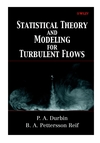 Paul Durbin
Paul Durbin Paul Durbin
Paul Durbin
Phone: 650-723-9311 | Fax: 650-725-3525 | Email: durbin@vk.stanford.edu
Computational Fluid Dynamics: Reynolds averaged flow computation, Direct numerical simulation on parallel computers:
Wakes and transition in turbines ( to Wu's page ), Bypass transition, Wall roughness
Scalar transport by turbulence, Convective heat transfer, Heat transfer in turbines ( to Medic's page )
 Statistical Theory and Modeling for Turbulent Flow, John Wiley 2001
Statistical Theory and Modeling for Turbulent Flow, John Wiley 2001
ISBN: 0471497444
"DNS of bypass transition"; "The Elliptic Relaxation Method"
chapters in
Closure Strategies for Turbulent and Transitional Flows
Cambridge Univ. Press, 2002
"Rough Wall Modification of 2-layer k-epsilon"
Durbin, P.A., Medic, G., Seo, J.M., Eaton, J.K. & Song, S.
ASME J. Fluids Eng., 123 , 16--21 (2001).
"Existence of longitudinal vortices evolved from distorted wakes in a turbine passage"
Wu, X. & Durbin, P. A.,
J. Fluid Mech., 446 , 199-228 (2001).
"Simulations of Bypass Transition"
Jacobs, R. & Durbin, P. A.,
J. Fluid Mech., 428 , 185--212 (2000)
"On algebraic second moment models"
Durbin, P. A.& Pettersson-Reif, B. Flow,
Turbulence and Combustion, 63 , 23-37 (1999).
"Prediction of heat transfer in a jet impinging on a heated
pedestal"
Parneix, S., Behnia, M. & Durbin, P. A.
ASME J. Heat Transfer, 121 , 43-49 (1998).
``Computation of 3-D turbulent boundary layers using the v2-f model''
Parneix, S., Durbin, P. A. & Behnia, M., Flow,
Turbulence and Combustion, 10, 19-46 (1998).
Sponsorship is from ONR, NSF, DOE, NASA and GE aricraft engines
The work on transition is
currently focussed on direct numerical simulation of bypass mechanisms.
This is carried out via numerical simulations on massively parallel computers. The relatively low Reynolds number makes numerical
simulation an attractive tool.
Research into turbulence modeling explores new analytical formulations.
Models are tested in a wide range of applications;
the practial aim is to improve existing methods
for computing engineering flows. Research on convective heat transfer
and scalar transport by turbulence is also in progress. Experimental
data are put to good use: one can regard analytical modeling as a
sophisticated method to extrapolate data.
Computational fluid dynamics methods for RANS and DNS simulation is a topic underlying much of this effort.
Current projects include:--
Near-wall modeling for non-equilibrium flows. New mathematical formulations for wall effects, coordinate rotation. Applications to date include diffusers, vortex-shedding bluff bodies, curved wall boundary layers, confined jets, high lift airfoils, flow and heat transfer in turbines.
Direct simulation of bypass transition in boundary layers. Free-stream turbulence, periodic passing wakes. Pressure gradient effects; streaks, spots and backward jets.
Flow and heat transfer in turbines: modeling the flow path through blade rows, unsteadiness due to incident wakes, effects of surface roughness, flow inside internal passages, film cooling, etc.
Passive scalar mixing in turbulent flows: simulations and modeling. Reacting flows, stochastic models.
Algorithms for rapid flow and heat transfer analysis of engineering designs.